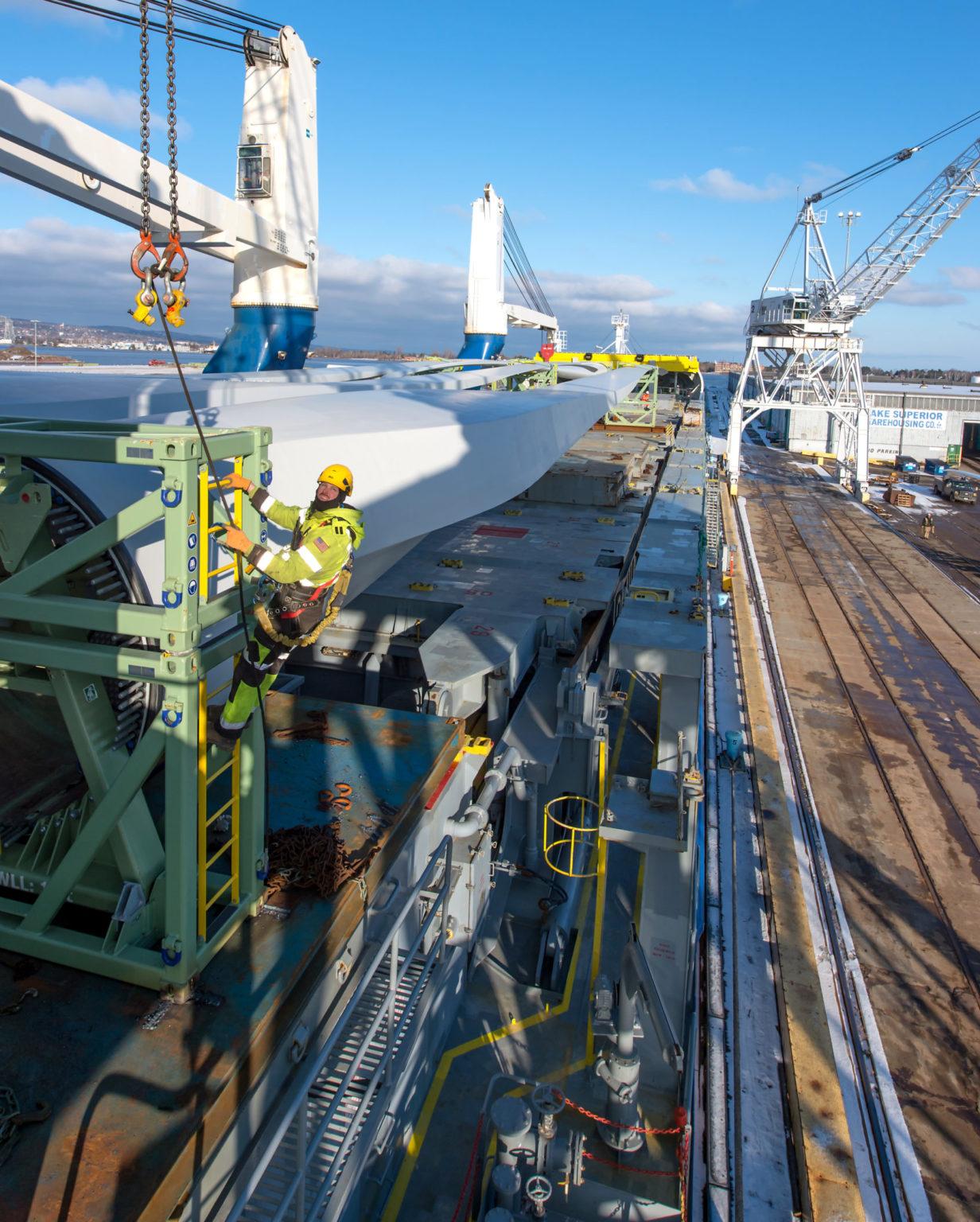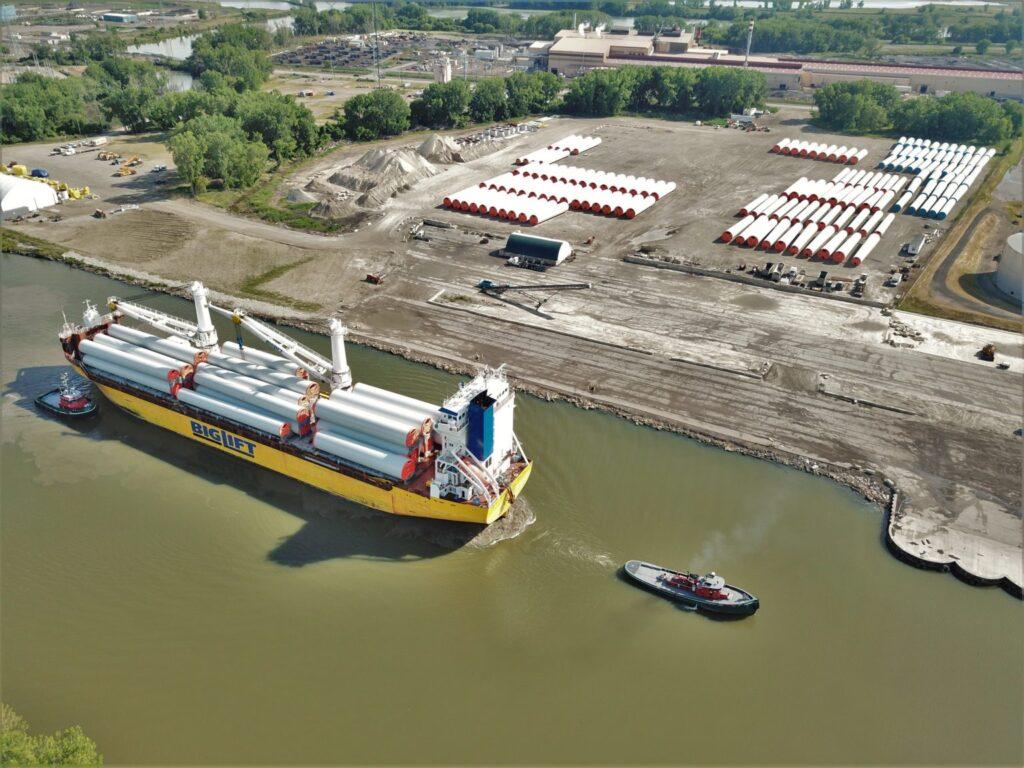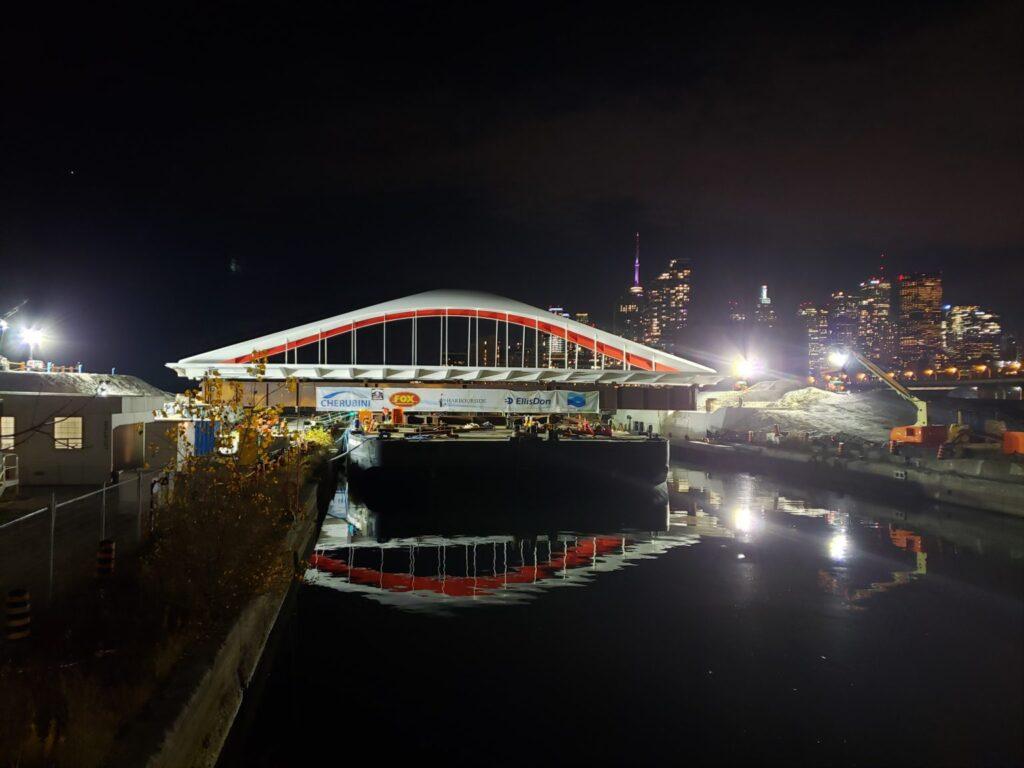
Ports in the Great Lakes-St. Lawrence region have been setting records in the handling of wind farm components manufactured domestically or abroad.Leo Ryan
Virtually anywhere you cast your eyes on the waters of the Great Lakes/St. Lawrence maritime corridor, you spot a specialized multi-purpose or heavy lift vessel transporting project cargo. There may be negligible loads of mining equipment destined for Alberta oilsands or machinery for factories still impacted by the global pandemic. But ports in this key economic region of North America have been setting records in the handling of wind farm components manufactured domestically or abroad.
In 2020, wind cargo shipments through the St. Lawrence Seaway doubled to more than 200,000 metric tons. It’s a reflection of the soaring expansion of the renewable energy sector, a sector expected to be further encouraged by the new Biden Administration in Washington and the Trudeau government in Ottawa.
Bright future for renewable energy
The Canadian Renewables Association of Canada is predicting a bright future for renewable energy.
“Despite considerable challenges posed by the global pandemic, Canada ended 2020 with a total wind capacity of 13,588 MW, a total solar capacity of approximately 3,000 MW, significant growth in energy storage and a positive forecast for 2021,” CanREA president Robert Horning recently said.
Wind power is currently estimated to be the world’s lowest-cost energy source, with prices having declined by 70% in the past decade. The capacity of Canadian wind energy projects slated for construction in 2021 is listed as 745 MW. Ontario and Quebec account for more than 9,000 MW of installed capacity.
However, Rystad Energy, a prominent world energy research consultancy based in Norway, forecasts that Alberta will emerge as the leader among Canadian provinces in utility-scale wind and solar assets as early as 2025 – potentially a boon for the Port of Thunder Bay, a major gateway for various projects in Western Canada.
For its part, the U.S. wind industry had its strongest year ever in 2020, with new power capacity surging 85% over 2019. This brought the total capacity to 122,478 MW, or enough to power 38 million American homes. States with installed wind power include Minnesota and Illinois in the Great Lakes, though Texas alone accounts for one quarter of the U.S. total.
Further growth foreseen on St. Lawrence Seaway
Bruce Hodgson, director of market development of The St. Lawrence Seaway Management Corporation, expects to see robust shipments of wind turbine components continue in 2021. The 2020 season, he says, witnessed equipment shipped “not just within the Great Lakes region, but in some cases, much farther inland than the system’s 3,700-kilometer marine highway.”
Hodgson explains: “Thunder Bay handled vessels of wind equipment for wind projects in Western Canada, one arriving with equipment from Germany and another from Spain. Duluth, along with Ogdensburg, Buffalo, Erie, Monroe, Bay City, Burns Harbor, Chicago and Menominee also handled wind project cargo shipments which originated from Spain, South Korea and Germany. “This highlights the benefit of keeping shipments on the water as long as possible in order to reduce the greenhouse gas footprint,” he says.

The Happy River ship delivers wind towers for General Electric to the Port of Monroe in Michigan. Photo Credit: Paul C. LaMarre III
2020 spectacular “big-lift” projects
Among Canadian Great Lakes ports, an impressive move handled by HOPA Ports (Hamilton Oshawa Port Authority) in 2020 was the shipment of a set of oversized power generation modules, manufactured in southern Ontario.
A spectacular convoy journey to the Port of Hamilton led by Precision Specialized lasted several days. The modules were then loaded onto the BBC Eagle at Federal Marine Terminals’ Hamilton port facility before departing for France.
“HOPA and its partners are looking forward to more heavy lift shipments in 2021, with new capacity in HOPA’s extended network in Oshawa and Niagara,” says Larissa Fenn, director of public affairs. “A newly-expanded facility at FMT in Hamilton offers improved docking and additional laydown area to accommodate more project cargo.”
Late in 2020, the Port of Toronto was the recipient of another striking project move: the delivery of the first of four new bridge spans that will connect Villiers Island to Toronto and the revitalized Port Lands. Manufactured by Cherubini steel fabricators, the 57-metre, 340-tonne bridge was transported on its long journey from Dartmouth, Nova Scotia aboard McKeil Marine’s tug and barge, the Lois M and Glovertown Spirit. Three more bridge loads are due to be completed during the 2021 Seaway navigation season.

This bridge is one of four that is being delivered by tug and barge from Nova Scotia to Toronto.
Port of Duluth “U.S. Midwest hub” for wind cargo
On the U.S. Great Lakes, the Port of Duluth-Superior’s 2020 record 525,000 freight tons of project cargo easily eclipsed 2019’s mark of 306,000 freight tons. The shipments by 30 oceangoing ships from eight countries included the longest wind blades (242 feet) and towers (100 feet) ever handled at the port. Looking beyond the numbers, Deb DeLuca, executive director of the Duluth Seaway Port Authority, stresses that “the Port’s emergence as a wind cargo hub is an important win for cargo diversity and for the expansion of renewable energy nationwide. Being North America’s furthest inland seaport really lends well to Duluth being the Midwest hub for wind cargo arrivals.”
The Port of Monroe in Michigan also benefitted from the largest project in its history in 2020, handling 14 vessels that delivered a total of 560 wind turbine segments from Bécancour, Quebec for General Electric’s wind energy activities in the state. The project helped offset the pandemic-related scarcity of cargoes at the beginning of the season. General Electric has a partnership with Monroe-based Ventower, which has produced several wind energy components for the company.
“If there is one word that defines the Port of Monroe during these challenging times it is ‘resilient,’”, says Paul LaMarre III, Port Director. “In the midst of an ever evolving economic and social climate, our team has adapted to new protocols and reinforced longstanding relationships leading to the Port’s most prosperous year in its history. As the home to one of only four wind tower manufacturers in the U.S., Ventower Industries, the Port has become a regional congregation and distribution hub for GE Wind.”

New general cargo/container service launched
Meanwhile, back in the Canadian Great Lakes, a small port to watch on Lake Ontario is Picton. Handling chiefly aggregate products (150,000 metric tons in 2020), it has big ambitions indeed.
Since purchasing the port facility in 2015, Odessa-based, family-owned Doornekamp Construction has invested substantially in the terminal infrastructure, expanding the dock area and equipping it notably with a Liebherr crane to handle heavy lift and project cargoes. On site is a fleet of two flat-deck barges, three hopper barges and two tugboats. But there is more.
The Doornekamp family has announced the launching in 2021 of a biweekly Picton-Halifax container service, using Canadian-flagged, geared general cargo vessels. Ben Doornekamp explains that “Doornkamp Lines will offer an alternate and different logistics solution for businesses. Presently, regional manufacturers have rail and trucking options to/from the Port of Montreal, but shortsea shipping on eastern Lake Ontario will provide companies with more options and opportunity to reduce costs to get their products to the global market.”